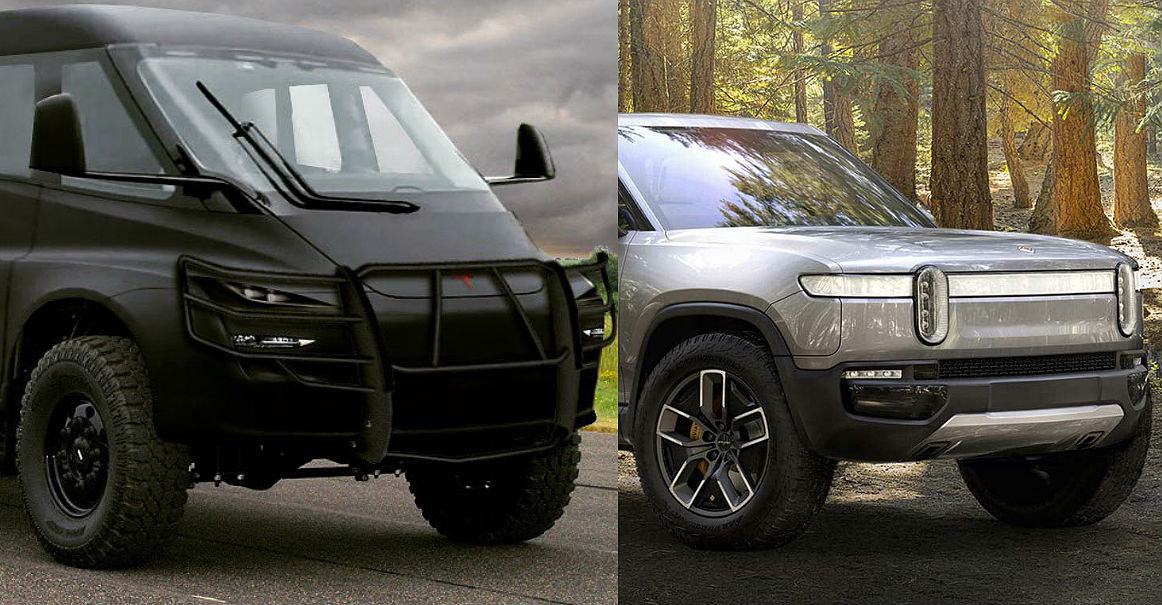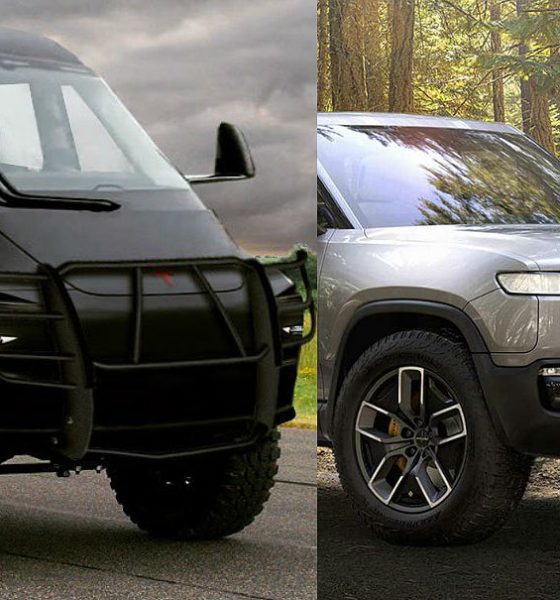

News
Tesla’s pickup truck and Rivian’s R1T can topple the mighty Ford F-150
The mighty Ford F-150 might see a legitimate challenge in the near future, if the veteran automaker neglects to prepare adequately for the arrival of two all-electric pickup trucks on the market — the Tesla Truck and the Rivian R1T.
The disruption of battery-powered pickup trucks was highlighted in a note from Morgan Stanley analyst Adam Jonas on Thursday. Addressing the firm’s investors, the analyst stated that an electric pickup successfully launched by a new player like Tesla or Rivian “could be a serious problem for the Detroit-based traditional automakers.” With the arrival of compelling vehicles, Jonas noted that experienced carmakers like Ford could lose the opportunity to gain a “first mover advantage” in the electric pickup market.
Promising Challengers

The Wall St analyst’s points hit the nail on the head, considering that the innate characteristics of electric vehicles such as instant torque and generous towing capacity are factors that are vital to the pickup truck market. The Rivian R1T, for example, is listed with a towing capacity of 11,000 pounds, though CEO RJ Scaringe noted in a recent interview that the truck could tow far beyond its official rating. Thanks to the R1T’s four electric motors, the truck is also able to hit 60 mph in just 3 seconds.
The Tesla Truck, on the other hand, has been mentioned several times by Elon Musk in recent months. Last year, Musk held a Twitter brainstorming session with his social media followers to list down features that are important for pickup truck owners. By the end of the session, Musk noted that the Tesla Truck would have two electric motors and dynamic suspension, a range of 400-500 miles per charge, four-wheel steering, a 240-volt connection for heavy-duty tools, and even an air compressor to run other equipment. Musk also noted that the vehicle could tow as much as 300,000 pounds.
Tesla’s Acid Test

Anyone skeptical of the potential disruption from an electric vehicle does not need to look very far. Over the past year, Tesla’s Model 3 midsize sedan all but shook the United States’ passenger car market, creeping up on ubiquitous vehicles like the Toyota Camry and dominating in revenue rankings. By the end of 2018, the Model 3 was the US’ best-selling luxury vehicle, despite being a sedan in a market that prefers SUVs and pickup trucks.
With a battery-powered pickup truck that is reasonably priced and well-equipped with features, carmakers such as Tesla and Rivian could challenge even the US auto industry’s biggest sellers, including the Ford F-150. One thing that would be a hindrance to this potential disruption, of course, would be the capability of electric car makers to scale production, especially considering the demand for pickups in the US. In this light, Rivian must still prove itself, since the production of the R1T is yet to begin. Tesla, on the other hand, is already learning the art of mass production, as shown by its growing pains with the Model 3 ramp.
A Way to Maintain the Status Quo

Despite the upcoming challenge and Wall Street’s recent warning, Ford does have a way to maintain the status quo in the pickup truck market. Last month, Jim Farley, Ford’s president of global markets, announced that the F-series would be going electric. Farley later added that the decision to adopt all-electric and hybrid power is a way to “future-proof” the company’s most successful vehicle line.
If recent sightings are any indication, it appears that Ford is at least testing an electric prototype of the F-150. As noted in a recent sighting, a camouflaged electric F-150 has been spotted charging at a station. The vehicle looked a lot like a regular truck, save for its charging port and its higher ride height, which appeared to be the result of batteries installed underneath the vehicle. Provided that Ford does not show some ill-timed hubris by giving the electric F-150 mediocre specs and range, the company could very well weather the storm of electric trucks coming its way.

Elon Musk
Elon Musk’s X will start using a Tesla-like software update strategy
The initiative seems designed to accelerate updates to the social media platform, while maintaining maximum transparency.

Elon Musk’s social media platform X will adopt a Tesla-esque approach to software updates for its algorithm.
The initiative seems designed to accelerate updates to the social media platform, while maintaining maximum transparency.
X’s updates to its updates
As per Musk in a post on X, the social media company will be making a new algorithm to determine what organic and advertising posts are recommended to users. These updates would then be repeated every four weeks.
“We will make the new 𝕏 algorithm, including all code used to determine what organic and advertising posts are recommended to users, open source in 7 days. This will be repeated every 4 weeks, with comprehensive developer notes, to help you understand what changed,” Musk wrote in his post.
The initiative somewhat mirrors Tesla’s over-the-air update model, where vehicle software is regularly refined and pushed to users with detailed release notes. This should allow users to better understand the details of X’s every update and foster a healthy feedback loop for the social media platform.
xAI and X
X, formerly Twitter, has been acquired by Elon Musk’s artificial intelligence startup, xAI last year. Since then, xAI has seen a rapid rise in valuation. Following the company’s the company’s upsized $20 billion Series E funding round, estimates now suggest that xAI is worth tens about $230 to $235 billion. That’s several times larger than Tesla when Elon Musk received his controversial 2018 CEO Performance Award.
As per xAI, the Series E funding round attracted a diverse group of investors, including Valor Equity Partners, Stepstone Group, Fidelity Management & Research Company, Qatar Investment Authority, MGX, and Baron Capital Group, among others. Strategic partners NVIDIA and Cisco Investments also continued support for building the world’s largest GPU clusters.
News
Tesla FSD Supervised wins MotorTrend’s Best Driver Assistance Award
The decision marks a notable reversal for the publication from prior years, with judges citing major real-world improvements that pushed Tesla’s latest FSD software ahead of every competing ADAS system.

Tesla’s Full Self-Driving (Supervised) system has been named the best driver-assistance technology on the market, earning top honors at the 2026 MotorTrend Best Tech Awards.
The decision marks a notable reversal for the publication from prior years, with judges citing major real-world improvements that pushed Tesla’s latest FSD software ahead of every competing ADAS system. And it wasn’t even close.
MotorTrend reverses course
MotorTrend awarded Tesla FSD (Supervised) its 2026 Best Tech Driver Assistance title after extensive testing of the latest v14 software. The publication acknowledged that it had previously criticized earlier versions of FSD for erratic behavior and near-miss incidents, ultimately favoring rivals such as GM’s Super Cruise in earlier evaluations.
According to MotorTrend, the newest iteration of FSD resolved many of those shortcomings. Testers said v14 showed far smoother behavior in complex urban scenarios, including unprotected left turns, traffic circles, emergency vehicles, and dense city streets. While the system still requires constant driver supervision, judges concluded that no other advanced driver-assistance system currently matches its breadth of capability.
Unlike rival systems that rely on combinations of cameras, radar, lidar, and mapped highways, Tesla’s FSD operates using a camera-only approach and is capable of driving on city streets, rural roads, and freeways. MotorTrend stated that pure utility, the ability to handle nearly all road types, ultimately separated FSD from competitors like Ford BlueCruise, GM Super Cruise, and BMW’s Highway Assistant.
High cost and high capability
MotorTrend also addressed FSD’s pricing, which remains significantly higher than rival systems. Tesla currently charges $8,000 for a one-time purchase or $99 per month for a subscription, compared with far lower upfront and subscription costs from other automakers. The publication noted that the premium is justified given FSD’s unmatched scope and continuous software evolution.
Safety remained a central focus of the evaluation. While testers reported collision-free operation over thousands of miles, they noted ongoing concerns around FSD’s configurable driving modes, including options that allow aggressive driving and speeds beyond posted limits. MotorTrend emphasized that, like all Level 2 systems, FSD still depends on a fully attentive human driver at all times.
Despite those caveats, the publication concluded that Tesla’s rapid software progress fundamentally reshaped the competitive landscape. For drivers seeking the most capable hands-on driver-assistance system available today, MotorTrend concluded Tesla FSD (Supervised) now stands alone at the top.
News
Elon Musk’s Grokipedia surges to 5.6M articles, almost 79% of English Wikipedia
The explosive growth marks a major milestone for the AI-powered online encyclopedia, which was launched by Elon Musk’s xAI just months ago.

Elon Musk’s Grokipedia has grown to an impressive 5,615,201 articles as of today, closing in on 79% of the English Wikipedia’s current total of 7,119,376 articles.
The explosive growth marks a major milestone for the AI-powered online encyclopedia, which was launched by Elon Musk’s xAI just months ago. Needless to say, it would only be a matter of time before Grokipedia exceeds English Wikipedia in sheer volume.
Grokipedia’s rapid growth
xAI’s vision for Grokipedia emphasizes neutrality, while Grok’s reasoning capabilities allow for fast drafting and fact-checking. When Elon Musk announced the initiative in late September 2025, he noted that Grokipedia would be an improvement to Wikipedia because it would be designed to avoid bias.
At the time, Musk noted that Grokipedia “is a necessary step towards the xAI goal of understanding the Universe.”
Grokipedia was launched in late October, and while xAI was careful to list it only as Version 0.1 at the time, the online encyclopedia immediately earned praise. Wikipedia co-founder Larry Sanger highlighted the project’s innovative approach, noting how it leverages AI to fill knowledge gaps and enable rapid updates. Netizens also observed how Grokipedia tends to present articles in a more objective manner compared to Wikipedia, which is edited by humans.
Elon Musk’s ambitious plans
With 5,615,201 total articles, Grokipedia has now grown to almost 79% of English Wikipedia’s article base. This is incredibly quick, though Grokipedia remains text-only for now. xAI, for its part, has now updated the online encyclopedia’s iteration to v0.2.
Elon Musk has shared bold ideas for Grokipedia, including sending a record of the entire knowledge base to space as part of xAI’s mission to preserve and expand human understanding. At some point, Musk stated that Grokipedia will be renamed to Encyclopedia Galactica, and it will be sent to the cosmos.
“When Grokipedia is good enough (long way to go), we will change the name to Encyclopedia Galactica. It will be an open source distillation of all knowledge, including audio, images and video. Join xAI to help build the sci-fi version of the Library of Alexandria!” Musk wrote, adding in a later post that “Copies will be etched in stone and sent to the Moon, Mars and beyond. This time, it will not be lost.”








